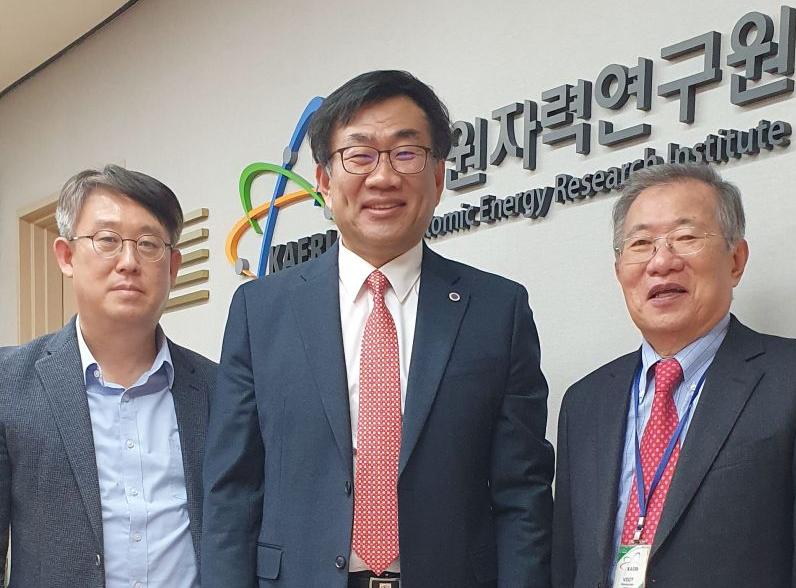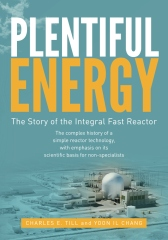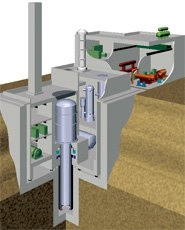 Dr. Yoon Il Chang, former deputy director of Argonne National Lab, visited KAERI to give a special lecture on SFR (Sodium Fast Reactor) based on IFR (Integral Fast Reactor) technology.
Dr. Yoon Il Chang, former deputy director of Argonne National Lab, visited KAERI to give a special lecture on SFR (Sodium Fast Reactor) based on IFR (Integral Fast Reactor) technology.
Dr. Chang emphasized the need to continuously develop SFRs with fuel-breeding characteristics in preparation for the future expansion of nuclear power.
The Story of the Integral Fast Reactor: The complex history of a simple reactor technology, with emphasis on its scientific basis for non-specialists
Authored by Charles E. Till, Yoon Il Chang
 The Integral Fast Reactor (IFR) is a fast reactor system developed at Argonne National Laboratory in the decade 1984 to 1994. The IFR project developed the technology for a complete system; the reactor, the entire fuel cycle, and the waste management technologies were all included in the development program. The reactor concept had important features and characteristics that were completely new and fuel cycle and waste management technologies that were entirely new developments. The reactor is a "fast" reactor - that is, the chain reaction is maintained by "fast" neutrons with high energy - which produces its own fuel. The IFR reactor and associated fuel cycle is a closed system. Electrical power is generated, new fissile fuel is produced to replace the fuel burned, its used fuel is processed for recycling by pyroprocessing - a new development - and waste is put in final form for disposal. All this is done on one self-sufficient site.
The Integral Fast Reactor (IFR) is a fast reactor system developed at Argonne National Laboratory in the decade 1984 to 1994. The IFR project developed the technology for a complete system; the reactor, the entire fuel cycle, and the waste management technologies were all included in the development program. The reactor concept had important features and characteristics that were completely new and fuel cycle and waste management technologies that were entirely new developments. The reactor is a "fast" reactor - that is, the chain reaction is maintained by "fast" neutrons with high energy - which produces its own fuel. The IFR reactor and associated fuel cycle is a closed system. Electrical power is generated, new fissile fuel is produced to replace the fuel burned, its used fuel is processed for recycling by pyroprocessing - a new development - and waste is put in final form for disposal. All this is done on one self-sufficient site.
 by Dr. Yoon Chang
by Dr. Yoon Chang
I will get to my particular reasons for working on a small modular IFR at the end, but first let me review some underlying considerations.
1. Technically small reactors are very sound.
If we can build 1000 Mwe plants, then 10 Mwe or 100 Mwe plants are that much easier. So I find a small reactor design, such as 4S (Super-Safe, Small & Simple)is technically sound and well designed. There is no magic about a long-life core. If you start with a derated core, say 6 times more fuel compared to convential 5 year core, then you have 30 year life with the same burnup level. Neutron damage on cladding will be higher, but since the netron flux level is lower at a derated core, the neutron dose increase is less than a factor of two, which is doable. However, this requires a good neutron economy, which metal fueled fast reactor provides. [By the way, the TWR is based on the same principle, except the moving part, which complicates the cooling arrangements.
Critique:
"To get the kind of breeding gains that enable a 7-year doubling time, you need a mighty high breeding ratio, and to get that, you need a mighty fast spectrum and super-rapid reprocessing.
Since one of the tenets of IFR/PRISM is no separated plutonium, please help me understand how you're going to accomplish this? Please also explain how you're going to keep the reactor controllable in this hard spectrum, since resonance absorption (Doppler effect) is really your only self-control mechanism, and you're above all the resonances in energy in this hard spectrum.
Softening the spectrum to make the reactor controllable has been what every LMFBR around the world has had to do to make the reactor even mildly controllable, and this kills off the breeding ratio really fast."
Current Fast Reactor Construction Projects
Russia resumed the construction of BN-800, primarily driven by the weapons Pu disposition application. India is constructing a 500 MWe Prototype Fast Breeder Reactor (PFBR), to be on-line in 2010. Subsequently four more units of the same size are planned in two sites by 2020.
China is constructing 65 MWth/20 MWe China Experimental Fast Reactor, to be on-line in 2009. Follow-on 800 MWe prototype FBR planned ~2020. Both China and India envision rapidly growing demand for nuclear and consider fast breeder reactors to be essential part of their future energy mix.
There is a growing international consensus that these five criteria are what the next-generation advanced nuclear system must meet to be broadly acceptable for the 21st
century and beyond, namely:
* Reduce the volume and toxicity of nuclear waste.
* Keep nuclear materials unsuitable for direct use in weapons.
* Be passively safe based on characteristics inherent in the reactor design and materials.
* Provide a long-term energy source not limited by resources.
* Be economically competitive with other electricity sources.
